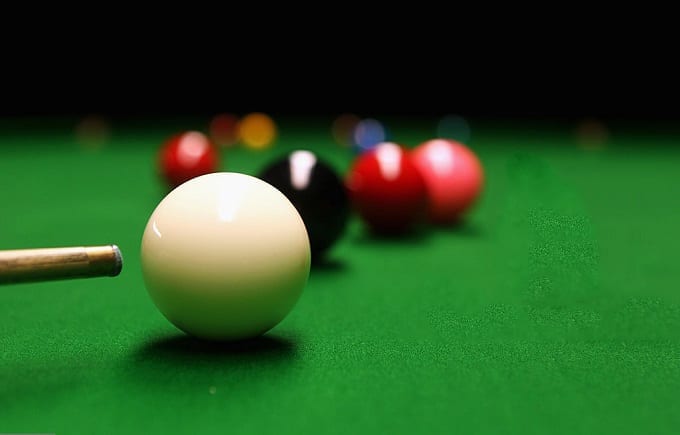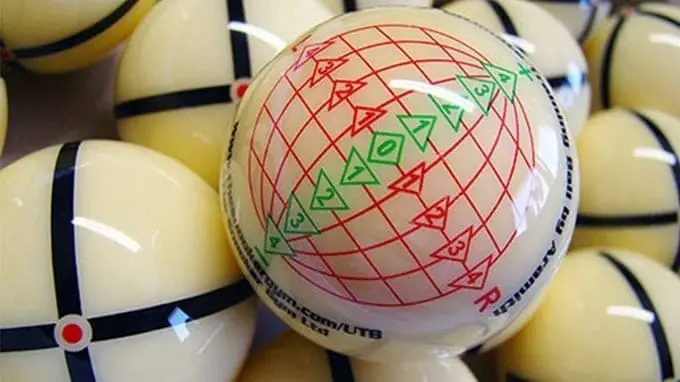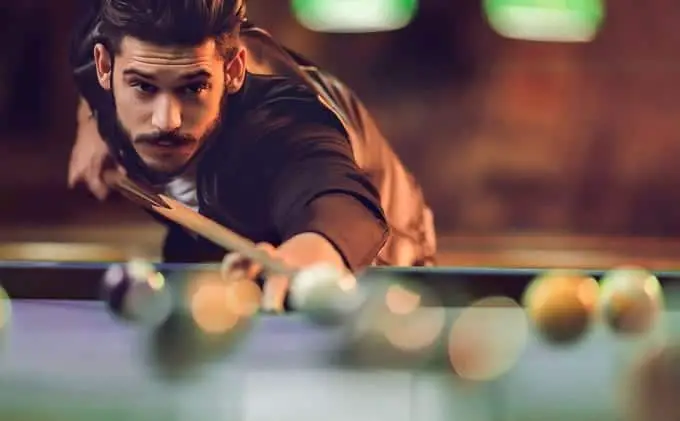If you’ve ever watched a professional pool player at the table, you’ll notice that their main focus is always on the cue ball.
This one ball has the potential to make or break the game and with it, you can do just about anything on the table, which is why the training cue ball has become such a huge phenomenon.
How does one learn how to control the cue ball the right way?
There are many different shots capable of the cue ball and it’s a simple matter of angles and force that can help you achieve it. Depending on the type of shot you’re performing and where you need it to go, there are some simple things you can do to make sure it follows your instruction.
This guide can walk you through to many types of shots you take with a cue ball and how putting a different spin on the ball can help you achieve whatever you need it to.
Learning to control the cue ball is the most important thing a pool player can do, and it’s the first step to take from amateur to serious player.
How Do You Control the Cue Ball?
In the game of pool, there are many different aiming systems that players use to control the cue ball.
As the ball which acts as the point between the cue and the object ball you’re trying to pocket, learning how to control just this one will be the key to success when learning this game.
How well you control the cue ball will depend on a few factors including the speed in which you hit it and the angle that it hits the other ball.
These factors can be adjusted by you as the player, and it’s why you see professional pool players spending a lot of their time setting up the shot to get them just right before they take a shot.
The easiest way to understand how the cue ball works are by lining up a shot and imagining the cue ball replacing whatever ball it is you’re trying to hit.
Follow the angle of where the cue ball is hitting the other one and it should give you a pretty good indication of where it’s going to end up.
However, this is easier said than done, and there are many different techniques you’ll need to master to ensure that it works.
How to Curve the Cue Ball
We don’t always want the ball to travel in a straight line on the table, and sometimes we’ll need it to curve around in order to reach its target.
Learning how to curve the cue ball so it travels on the path you require can take some practice, but it’s definitely doable.
The first thing you need to do is set up the cue ball so that it’s lined up with your object ball and the pocket you want to hit.
Your speed should be just enough so that the object ball makes it to the pocket, so you need to know how to stop it as soon as it hits. Once it’s set up, you can then make your next move.
Depending on what way you want to curve it, you’ll need to work at around 30-45 degrees of elevation.
Some find it easier to go from the left but it will depend on where your object ball is situated and if there are any obstacles in the way.
Aim for around 3 o’clock on the ball and it should curve just enough to reach the pocket.
How to Put a Topspin on the Cue Ball
Although it might look like an easier shot, achieving a topspin on your cue ball can actually take a lot of practice.
With topspin, the cue will hit the ball just about its center and the higher you hit this target, the more spin you’ll achieve.
This type of shot is sometimes referred to as the follow-through because the cue ball will follow the object ball after they’ve connected.
To perform a topspin, line up the cue ball with the object ball and aim to hit it just above the center.
When applied correctly, a topspin will cause the cue ball to follow through after it hits the object ball.
Use as much force as needed to make your shot, remember that using a topspin will cause the ball to travel further than if you used another type of shot so it’s better left for times when the distance is required.
Experts believe the key to a correct topspin is the force in which you push the cue, and it should be a slow acceleration rather than a powerful shot.
Push the cue towards the object ball in a straight line and follow-through, and that’s how you achieve the perfect topspin.
How to Put a Backspin on the Cue Ball
A backspin is also known as the draw shot, and this type of shot should be used when you want the cue ball to draw back after hitting the object ball.
The main purpose of this type of shot is the set up your position to pocket a ball, so you need to make sure it?s been hit at the right angle so that it will actually draw the ball backward.
To perform a backspin or draw shot, location is everything.
Your goal should be to hit around one cue tip’s width just below center and if you want even more draw, you can lower this marker just a small amount or apply more force when you hit it.
Once the ball has been hit, follow through with your pool cue around 5 inches after the contact point and move towards the object ball.
It’s easy to practice this shot by trying to hit different locations for the draw.
You should be trying to draw the ball back to specific spots, and once you’re able to master this from all directions you’ll find it very easy to set your shots up.
How to Put a Sidespin on the Cue Ball
Sidespin is a common technique that affects the angle that the object ball will take after it’s been struck.
This type of move is sometimes referred to as ‘English’ but it could also just be a right or left spin depending on the angle.
To perform sidespin, you need to line up the cue ball so that you can easily strike the object ball on either the left or right side.
Where you hit it will depend on the angle you need it to take, with the further right you make contact the sharper the left angle will be.
The purpose of this shot is to set up and position the other balls, but sometimes it can be used to reach a pocket.
Learning the angles is harder than it looks though and there are sometimes errors when the ball doesn’t move in the exact same direction you’d hoped.
Tips for Controlling the Balls in Pool
There are some expert tips you can follow that will make ball control easier, and if you can remember to apply them you’ll have a much easier time mastering the cue ball.
Think about these the next time you play when you’re trying to learn control of your cue ball.
Practice with just the cue ball

Before you can become a good pool player you need to master the cue ball on its own.
Spend as much time as needed learning how to control the cue ball without any other balls on the table.
Once you know how to do this, it’ll be a lot easier to perform the various shots required.
Choose the right starting spot
When the game starts, it’s all about choosing the ideal position to break.
If playing on a public table, you can usually see the most common place to start by noticing scuff marks on the table.
There’s a good chance this is the path you should follow based on who’s played there before you.
Get a good stance
Having your stance figured out will help you control the cue stick and ball a lot easier.
Some favor their left or right foot forward depending on what’s comfortable and keep in mind that for different shots you’ll want to adjust your positioning to get it right.
Are Training Cue Balls Necessary?

Training cue balls are a relatively new product in the game of pool but some might find them helpful when learning how to control the game.
A training cue ball is a standard-sized ball that features patterns and markings embedded on its surface that shows specific angles and sweet spots that you should be aiming for to make certain types of shots.
The purpose of these balls is to help teach spin effects and learn to control the cue ball, and they usually come in both advanced and beginner styles.
Although they can be helpful, they aren’t the only way to learn, and most expert players have managed to pick up the game without one.
However, depending on your learning style and how much support you think you need, it could be a great way to learn the basics of cue ball control.
Why Your Pool Cues Matter
In addition to learning how to control the cue ball, we can easily forget about just how important our pool cues are in helping us achieve this.
The cue stick is the one thing between us and the ball, so choosing one with the right features will actually make it a lot easier to gain control of the balls on the table.
The most important feature is the tip, with four main types each offering something unique. There are soft, medium, hard, and phenolic tips.
Softer tips are better suited for spins, whereas harder tips are ideal for breaking.
A medium tip is the best way to achieve both types of strokes, but more serious players will have a range of pool cues in their arsenal to meet all of these different moves.
The length and weight of the pool cue will also be important and it should match your own physical requirements.
A standard pool cue is between 57-58 inches and suits average height people, but if you’re shorter or taller than most you’ll want to adjust.
The best weight for a beginner is between 19.5 – 21 oz, and as your skills progress and you find control easier, you should opt for something lighter still.
Related Questions
The pool is a game with many calculations and considerations to get right, and learning can take a lot of time and patience.
Controlling the cue ball is a fundamental skill to learn in the game of pool and we’ve answered some commonly asked questions about how to get it right.
Should You Look at the Cue Ball or Object Ball?

Your focus should always be on the object ball when lining up and taking your shots in the pool to give you the most accurate position.
Hold the gaze on the object ball after the shot has been performed so you can see the trajectory it takes.
How Do You Hold a Pool Cue For Control?
Place your left hand on the table to make a bridge which is where the cue will rest, and choose the groove in your hand that will help you achieve the shot.
Use the thumb, index finger, and middle finger to hold the butt cap of the pool stick and line up the shot.
What is the Best Cue Tip Size?
The best size for each player will depend on their skill level.
For most players with intermediate skills, a 13mm cue tip will be adequate. The larger the tip the more likely you are to hit the ball, but it takes some practice.
Other articles you may like:
- How to Replace a Pool Cue Tip?
- Graphite Pool Cues vs. Wood Pool Cues – What’s the Difference?
- What Are Low Deflection Pool Cues
- Is Pool a Sport? All You Need to Know
